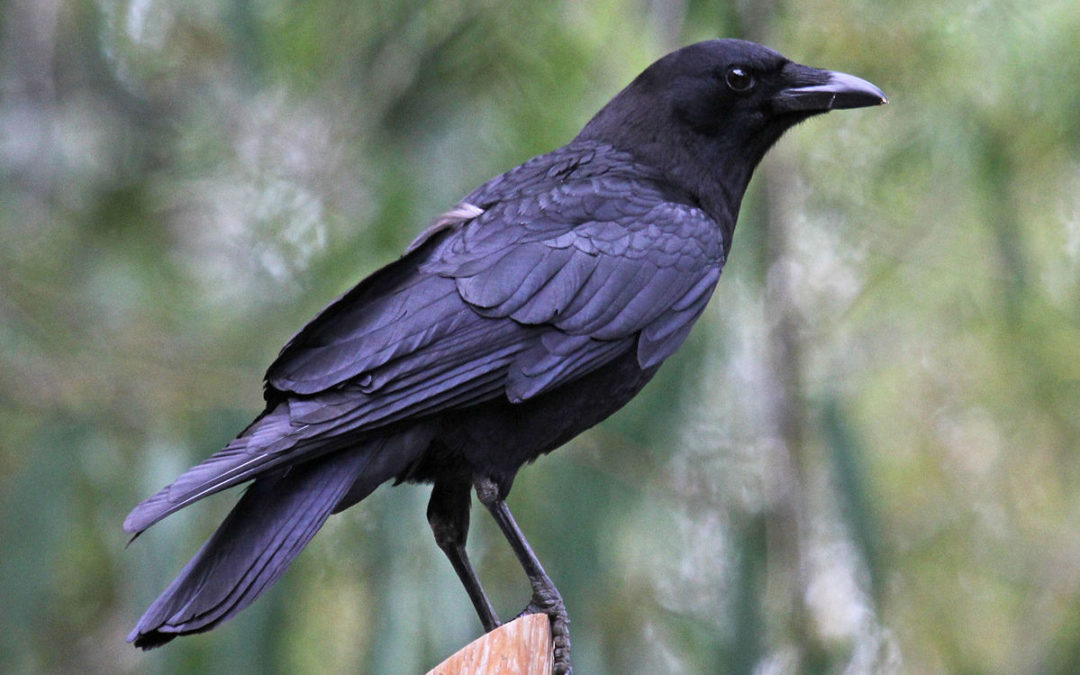In an effort to counteract the effects of holiday treats, after-work walks in my neighborhood have been more frequent this fall. Living in town, these evening walks are usually accompanied by the “caw, caw, caw” of crows. I easily recognize their large silhouettes and their distinct, steady wing beats against the early darkening sky. Their wings make slightly circular motion as if they were rowing through the air.
How often do we lose sight of the ordinary? We see something so many times it becomes invisible. “Oh it’s just a….” Crow, House Sparrow, Dandelion. What can you fill in that blank from your daily life? What is something you’ve stopped looking at because you see it so frequently?
Recently for me, it is crows. If I think about it, I probably see a crow almost every time I’m either outside or have a view of the sky. Crows live all over the world, except Antarctica. In this region, and much of the United States, the crow we regularly see is the American or Common Crow.
In addition to being ordinary, wild animals that hang around humans don’t seem as valuable or as interesting as other species. We often judge them unworthy of our attention. The difficulty of finding photos of crows in both my own and Audubon’s collection stands as a testament to that. So let’s give crows a little more credit. Just as the Lorax spoke for the trees, I’ll take a moment and speak for the crows.
We see them so frequently around human landscapes because they are incredibly adaptable. Crows can live anywhere there are some trees and a source of food, not bothered much by the human goings-on around them. They are found in residential areas and city parks as well as farmland and other open spaces.
A key reason for their adaptability is their varied diet. Crows eat almost anything — earthworms, insects, small animals, young birds, fruit, seeds but also pet food and garbage. And to get at this food, they are clever and cunning. Crows have been witnessed following birds back to their nests, stealing food from other animals and also using simple tools to get food.

One of several trees full of American Crows as they settle down to roost in the evening. Photo by Katie Finch
Crows also eat dead animals. This may sounds disgusting at first but crows play an important role in the ecosystem as garbage collectors. Along with other scavengers, they clean up the dead in the forest, field, parks and roadsides. Just as we humans would be in a horrible (and stinky) predicament without our trash collectors, we would also be stuck without crows. And at least they can turn nature’s trash into food, aka energy.
Researchers have found that crows have strong family bonds. Crow mates stay together year round and often mate for life. The family groups can be as large as fifteen individuals because the young stick around with their parents for a few years. They are not loafers. They earn their keep by helping raise young, bringing food to the adult on the nest, keeping predators at bay, and mobbing larger birds who see them as food.
Crows are incredibly social birds. They will feed together during the day, and then sleep, or roost, together at night. In the winter, these groups can number in the hundreds or even thousands. There is safety in numbers.
It is this movement to the communal roosting areas that I see on my walks. In the evening the crows mostly move in the same direction one after the other after the other as if being pulled by a magnet. Their destination? Trees to sleep in. I wonder how they choose their roosting spots. In town, I’ve spotted hundreds of crows in towering spruce trees in an otherwise treeless neighborhood, in deciduous trees along the river and in the tree-filled cemetery. While this may be viewed as a nuisance if they are roosting in the trees in your backyard, I find it fascinating. It is just a glimpse of what it must have been like 200 years ago when naturalists, such as John James Audubon witnessed flocks of birds so numerous they blocked out the sun.
These gatherings of crows are also known as murders. The origin of that term is not certain but it is one among many of the outrageous sounding group names for animals. (How about a parliament of owls or a charm of finches?) But how sinister a murder sounds! And given these birds are all black and gather in such high numbers in the winter I understand why some people may be leery of them.
But what I like the most about crows is that they are not only more complicated than we think but they make nature more accessible than we often think it is. Nature doesn’t have to be far away, exotic and hard to reach. It can be right in your neighborhood. The challenge for us is finding wonder in the ordinary.
Audubon Community Nature Center builds and nurtures connections between people and nature. ACNC is located just east of Route 62 between Warren and Jamestown. The trails are open from dawn to dusk as is Liberty, the Bald Eagle. The Nature Center is open from 10 a.m. until 4:30 p.m. daily except Sunday when it opens at 1 p.m. More information is online at auduboncnc.org or by calling (716) 569-2345.
Katie Finch is a naturalist at Audubon.


Recent Comments